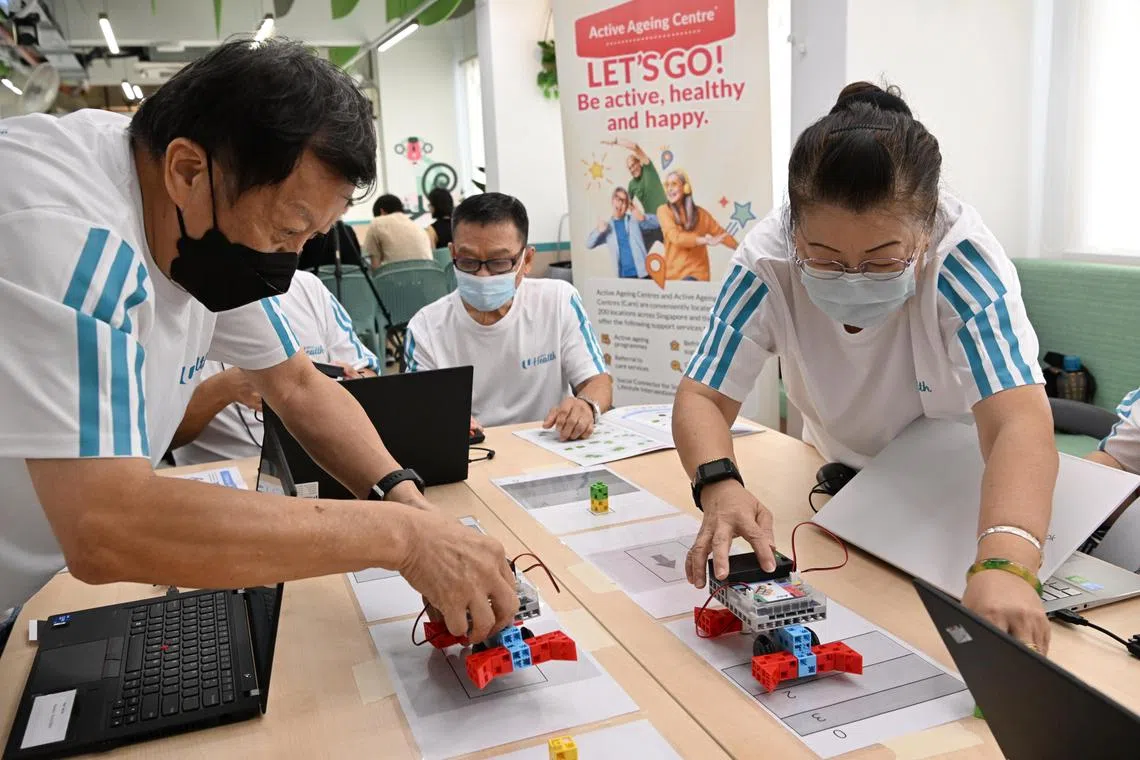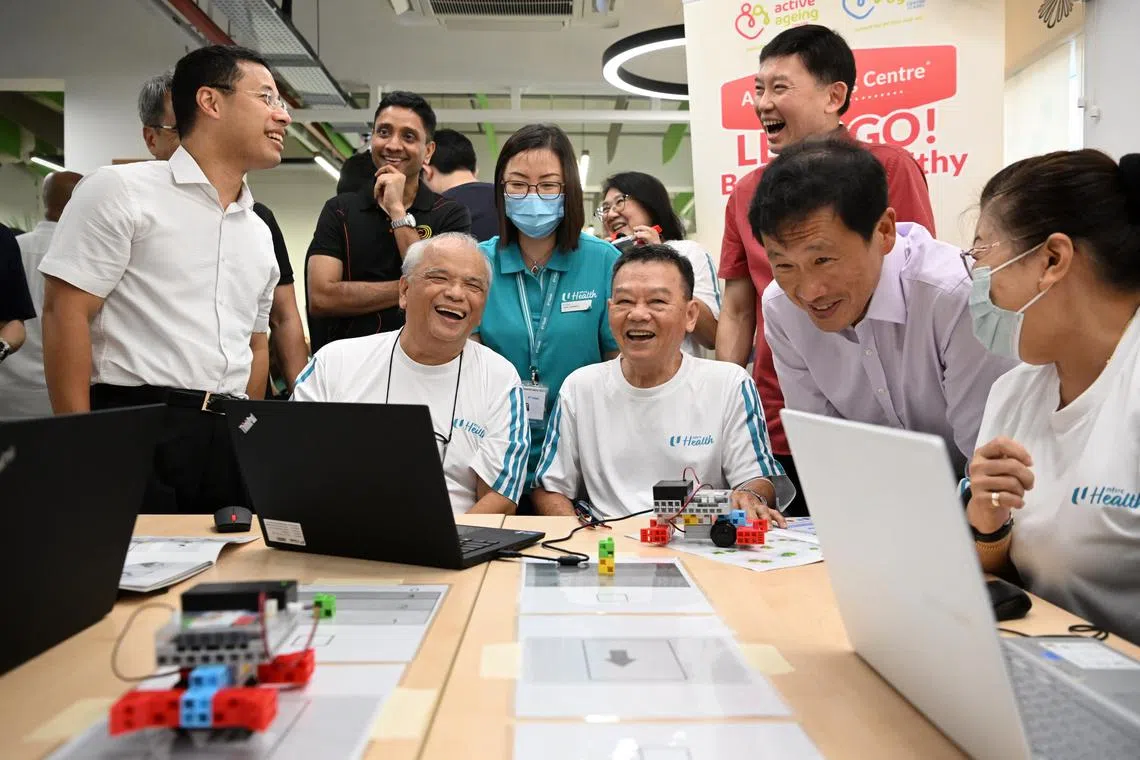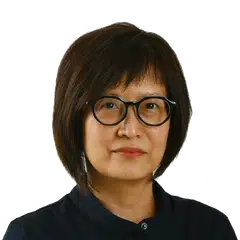Singapore sets aside $800m to help seniors age well at home, in their communities
Sign up now: Get ST's newsletters delivered to your inbox

Seniors attending a robotics and coding programme at the newly renovated NTUC Health Active Ageing Centre in Lengkok Bahru on Nov 15.
ST PHOTO: CHONG JUN LIANG
Follow topic:
SINGAPORE – More seniors will be supported to age well in the community under a programme that will set aside $800 million over five years for active ageing centres to expand their outreach and increase the range and quality of programmes.
Announcing the increased funding and other details of a multi-ministry Age Well SG programme
He was speaking at a press conference at the NTUC Health Active Ageing Centre in Lengkok Bahru, Bukit Merah, on Thursday.
There will also be improvements made to housing and streets under the Age Well SG programme, which is also spearheaded by the Ministry of National Development (MND) and Ministry of Transport.
Singapore is ageing rapidly.
Mr Ong said each active ageing centre’s annual budget hovers around $400,000 and the fund injection would lead to a budget rise of at least 50 per cent.
“With greater resourcing, we also have higher expectations for agencies now,” he added. “It is not difficult to fill out an AAC (active ageing centre) with the same visitors every day. It is much more difficult to be able to reach out to the great majority of seniors all living around (the AAC) and able to engage them in meaningful ways.”
The activities at the AACs are meant to keep seniors healthy, but they must also suit the preferences of those living in the vicinity, he said. Communal dining is one activity that allows them to make friends.
Active ageing centres will also work with community partners such as Sport Singapore or the People’s Association, and make use of all the spaces in the community, including coffee shops, pavilions and community clubs.
They will need to work closely with healthcare clusters to implement health screening services in the community and integrate with the Healthier SG preventive health strategy to keep Singaporeans healthy.
At the NTUC Health Active Ageing Centre in Lengkok Bahru, for instance, there is a weekly community health post manned by nurses and a well-being coordinator from Singapore General Hospital, who can help seniors with, say, smoking cessation, counselling and advance care planning, or connect them with home care services.
Active ageing centres will be supported by Silver Generation or SG ambassadors and new senior volunteers whom they can recruit.
The Agency for Integrated Care (AIC) will roll out a programme to train senior volunteers to run programmes at active ageing centres or befriend seniors at risk of social isolation.
Mr Ong said the aim is to double the number of senior volunteers trained by AIC to around 4,000 by 2025, up from around 1,900 Silver Generation ambassadors at the moment.
“Volunteerism is a very important way for seniors to feel that they can continue to contribute to society and the people around. It will be a core function of the AACs to drive senior volunteerism,” he added.
While active ageing centres are meant for seniors who are well, those with care needs can look forward to a wider range of solutions. The Ministry of Health (MOH) and AIC, with support from the Manpower Ministry, have launched applications for a sandbox scheme to explore the viability of new stay-in shared caregiving models in the private sector.
Five companies, including one that offers assisted living in houses, have been identified for the sandbox scheme, with the aim of servicing an estimated 800 seniors. The models will be reviewed within two years, and, if they work, they will be scaled up, Mr Ong said.
A shared caregiving model may see a few seniors living together in the same flat. They form a new kind of family, a social circle, and can support one another, he added.
“At the same time, within this new household of a few seniors, you can have caregivers at less than the ratio of one to one... And that way, we’ll also reduce the manpower needed to deliver the care services,” he said.

National Development Minister Desmond Lee (left), Health Minister Ong Ye Kung (second from right) and Acting Minister for Transport Chee Hong Tat (in red) joining seniors during a robotics and coding programme at the NTUC Health Active Ageing Centre in Lengkok Bahru on Nov 15.
ST PHOTO: CHONG JUN LIANG
Participating companies will be eligible for work permit quotas and foreign manpower concessions to give them the flexibility of recruiting caregivers from traditional and non-traditional sources.
For seniors who may have to undergo repeated assessments at multiple care providers, MOH will introduce a single point of contact to coordinate all their care needs.
This will happen progressively from the second half of 2024, and will provide the seniors and their caregivers with a more seamless care journey.
The coordinating provider will use a standardised care assessment tool to plan for a senior’s care needs, which will reduce the need for multiple assessments and unnecessary referrals by different care providers.
For instance, a senior who is discharged from hospital after a fall can be referred to an active ageing centre, which will be his single point of contact.
The centre can arrange for him to receive home personal care and senior care centre services provided by a different centre.
And, from April next year, caregivers will be able to tap up to $400 in Caregivers’ Training Grant per year, double the $200 currently. They can also use their SkillsFuture Credit to pay for eligible caregiver courses.
Another part of Age Well SG involves improvements to the living environment. National Development Minister Desmond Lee said a bigger, more concerted push will be made to address seniors’ needs in the built environment.
At home, seniors will get more senior-friendly features, including bigger easy-to-press switches, home fire alarm devices and foldable shower seats in their Housing Board (HDB) flats, as MND expands the Enhancement for Active Seniors (Ease) programme into Ease 2.0,
A wireless alert alarm system will be progressively expanded to all seniors living in public rental housing,

A wireless alert alarm system will be progressively rolled out to all seniors living in public rental housing.
ST PHOTO: CHONG JUN LIANG
Outside the home, senior-centric upgrading works will be progressively rolled out in more than 20 older precincts with a high density of seniors, including Ang Mo Kio and Bukit Merah.
These include enhancements such as barrier-free access ramps and amenities like fitness trails.
To provide Singaporeans with more assisted-living options, MND, MOH and HDB will launch up to 30 Community Care Apartment projects by 2030.
These flats pair senior-friendly housing with on-site social activities and care services that can be customised according to their needs.
The first Community Care Apartment residents will move in next year, when their Bukit Batok flats are ready.
Singapore’s second Community Care Apartment project, in Queensway, was launched in late 2022.
A third one in Bedok will be available in the upcoming HDB Build-To-Order sales exercise in December.
By 2030, all towns will have “friendly streets”,
Having safe roads, friendly streets and accessible facilities will give seniors the confidence to move around, he added.


